Animals that start with Y are often overlooked, yet they’re some of the most charming creatures in the animal kingdom.
From furry mammals to colorful birds and unique sea inhabitants, these species offer a glimpse into nature’s diversity.
This article will introduce you to over 30 animals whose names begin with Y. We’ll explore their habitats, behaviors, and interesting facts that make each one special.
Get ready to study animals you may have never heard of, like the yak, yellowhammer, and yeti crab.
You’ll learn about their roles in ecosystems and why some are facing challenges in the wild.
Whether you’re a nature enthusiast or simply curious, this guide to Y-named animals will expand your knowledge of the animal world.
Animals that Start with Y
This section showcases a variety of animals whose names begin with the letter Y. From well-known creatures to rare species, you’ll find a mix of mammals, birds, fish, and more.
Each animal has its unique traits and story. Let’s explore these Y-named animals and learn what makes them special.
1. Yak

The yak is a large, hairy bovine native to Tibet, China, and Central Asia. Its long, thick hair protects it from extreme cold.
Yaks can reach up to 7 feet at the shoulder and weigh between 1,000 and 1,500 pounds.
They are well-adapted to high altitudes, where oxygen levels are low, making them an essential part of the ecosystem in the Himalayas.
- Region of Habitat: Tibet, China, and Central Asia
- Scientific Name: Bos grunniens
- Place of Origin: Himalayas
- Feeding Habits: Herbivorous, primarily grazing on grasses and herbs
- What Sound They Make: Grunts and snorts
Fun Facts: Yaks are incredibly resilient animals, capable of surviving in harsh conditions where few other mammals can thrive.
They have large lungs and a high red blood cell count, which helps them endure low oxygen levels at high altitudes.
Local populations use domesticated yaks for their milk, meat, and wool. They are also known for their ability to carry heavy loads across difficult mountain terrain.
2. Yabby

The yabby is a freshwater crayfish native to Australia. It is known for its ability to survive long periods of drought by burrowing into the soil.
The yabby can reach up to 8 inches in length and weighs around 0.5 pounds. Depending on its environment, its coloration can range from brown to blue.
This species often occurs in slow-moving rivers, streams, and lakes across Australia.
- Region of Habitat: Australia
- Scientific Name: Cherax destructor
- Place of Origin: Australia
- Feeding Habits: Omnivorous, feeding on plants, algae, and small invertebrates
- What Sound They Make: No audible sound; they are silent creatures
Fun Facts: The yabby is a highly adaptable species, surviving in freshwater and brackish environments.
During droughts, they burrow deep into the soil to retain moisture, allowing them to survive even in harsh conditions.
Yabbies are also popular in aquaculture and are sometimes kept as pets in home aquariums.
3. Yeti Crab

The yeti crab is a unique deep-sea crustacean known for its hairy arms, which it uses to develop bacteria as a food source.
It was found near hydrothermal vents in the South Pacific Ocean. The yeti crab can grow up to 6 inches in length and is characterized by its pale, almost translucent shell and reduced eyesight due to its deep-sea habitat.
- Region of Habitat: South Pacific Ocean, near hydrothermal vents
- Scientific Name: Kiwa hirsuta
- Place of Origin: Hydrothermal vents near Easter Island
- Feeding Habits: Bacteria and small organisms
- What Sound They Make: No audible sound; they are silent creatures
Fun Facts: The yeti crab was first located in 2005, and its peculiar appearance, including its hairy arms, immediately captured the attention of scientists.
The bacteria growing on its arms provide sustenance for the crab, a unique adaptation to the nutrient-poor environment of the deep sea.
Despite its fearsome appearance, the yeti crab is harmless and relies on its symbiotic relationship with bacteria for survival.
4. Yellow Anaconda

The yellow anaconda is a large, non-venomous snake found in South America. It can grow up to 15 feet in length and weigh up to 80 pounds.
Its body is covered in a pattern of yellow, green, and brown scales, which helps it blend into its wetland habitats.
Yellow anacondas are known for their strength and ability to subdue large prey, including capybaras and caimans.
- Region of Habitat: South America, particularly in Paraguay, Brazil, and Argentina
- Scientific Name: Eunectes notaeus
- Place of Origin: South American wetlands
- Feeding Habits: Carnivorous, preying on mammals, birds, and reptiles
- What Sound They Make: Hissing
Fun Facts: Yellow anacondas are among the largest snakes in the world, though they are smaller than their relative, the green anaconda.
They are powerful swimmers and spend much of their time in or near water. When threatened, they may coil their bodies defensively and emit a loud hiss to deter predators.
Despite their size, they are not typically aggressive towards humans.
5. Yellow Baboon

The yellow baboon is an Old World monkey species found in East Africa. Its slim build, yellowish-brown fur, and long limbs characterize it.
Adult males can weigh up to 55 pounds, while females are smaller, weighing around 30 pounds. Yellow baboons are highly social animals, living in large troops led by dominant males.
- Region of Habitat: East Africa, including Kenya, Tanzania, and Zimbabwe
- Scientific Name: Papio cynocephalus
- Place of Origin: African savannas and woodlands
- Feeding Habits: Omnivorous, eating fruits, seeds, insects, and small mammals
- What Sound They Make: Barks, grunts, and screams
Fun Facts: Yellow baboons are highly adaptable and thrive in various environments, from savannas to forests.
They have complex social structures, with strong bonds formed between individuals. These baboons are known for their intelligence and can use tools to obtain food.
They also engage in grooming behaviors, which help strengthen social ties within the troop.
6. Yellow-Bellied Sapsucker
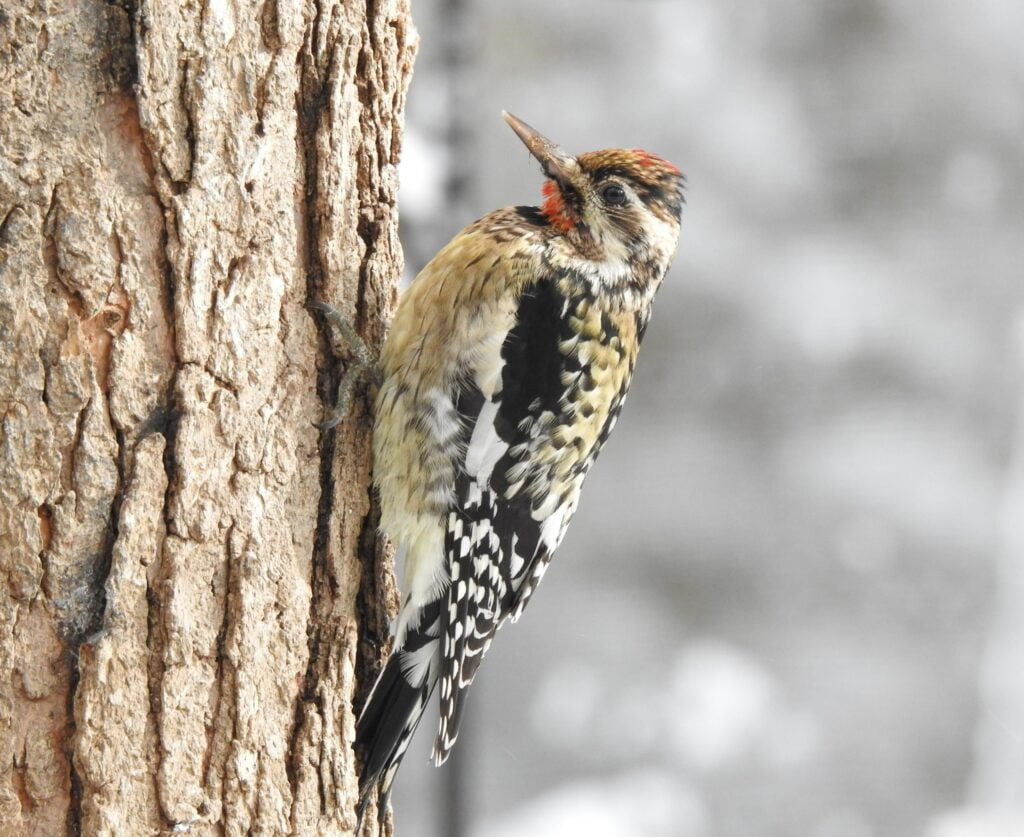
The yellow-bellied sapsucker is a medium-sized woodpecker found in North America. It has a distinctive yellow belly, a black-and-white striped face, and a red forehead.
These birds can grow up to 8 inches in length with a wingspan of about 14 inches. They are known for drilling rows of small holes in trees to extract sap, which they consume along with trapped insects.
- Region of Habitat: Eastern and Central North America
- Scientific Name: Sphyrapicus varius
- Place of Origin: North American forests
- Feeding Habits: Primarily sap, insects, and fruits
- What Sound They Make: Drumming on trees, calls include nasal mewing sounds
Fun Facts: Yellow-bellied sapsuckers play a crucial role in their ecosystems by creating sap wells that other species, such as hummingbirds and bats, use as food sources.
These woodpeckers can remember the location of productive sap wells and return to them year after year.
Their migratory patterns cover vast distances, with some traveling from Canada to the southern United States during winter.
7. Yellow Bullhead
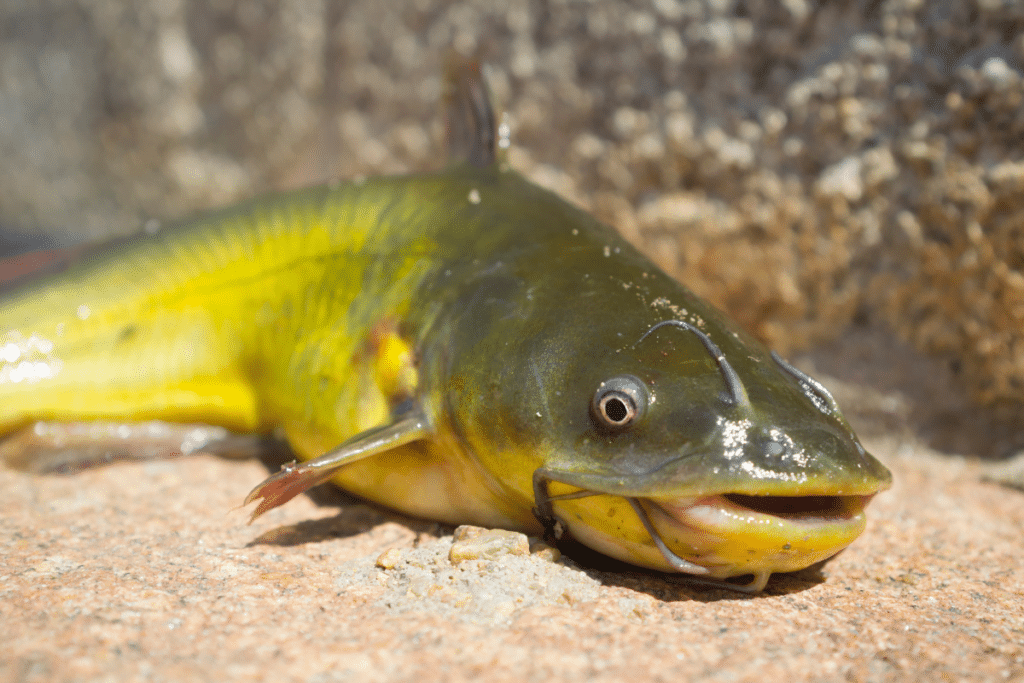
The yellow bullhead is a North American species of catfish. It typically grows to about 9 to 14 inches in length and weighs 1 to 2 pounds.
The yellow bullhead is recognizable by its yellowish-brown body and four pairs of barbels around its mouth, which help it detect food in murky waters.
These fish are known for their hardy nature and ability to thrive in various aquatic environments.
- Region of Habitat: North America, particularly in the eastern United States
- Scientific Name: Ameiurus natalis
- Place of Origin: Freshwater rivers, lakes, and streams in North America
- Feeding Habits: Omnivorous, feeding on insects, small fish, and plant material
- What Sound They Make: No audible sound; they are silent creatures
Fun Facts: Yellow bullheads are bottom dwellers, often found in slow-moving or stagnant waters.
They have a keen sense of smell, which they use to locate food in the dark or murky waters they inhabit.
These catfish are known for their resilience and can survive in environments with low oxygen levels where other fish might struggle.
8. Yellow Crazy Ant

The yellow crazy ant is an invasive species known for its erratic movements and devastating ecosystem impact.
These yellowish-brown ants measure around 5 millimeters in length. They lack a stinger but can spray formic acid to defend themselves.
They are highly aggressive and form large colonies, often displacing native species in the regions they invade.
- Region of Habitat: Originally from Southeast Asia, it is now found in many tropical and subtropical areas.
- Scientific Name: Anoplolepis gracilipes
- Place of Origin: Southeast Asia
- Feeding Habits: Omnivorous, feeding on insects, small animals, and honeydew from aphids
- What Sound They Make: No audible sound; they are silent creatures
Fun Facts: The yellow crazy ant is considered one of the world’s worst invasive species. They have caused significant ecological damage, particularly on islands where they disrupt the native fauna.
These ants are known for their unusual behavior, moving in rapid, unpredictable patterns when disturbed, which gives them their name.
9. Yellow-Eyed Penguin

The yellow-eyed penguin, or “hoiho,” is a rare and endangered species in New Zealand.
It is distinguished by its pale yellow eyes and a yellow band of feathers that runs from its eyes around the back of its head.
These penguins can grow up to 30 inches tall and weigh between 11 and 18 pounds. They are one of the most ancient and unique penguin species.
- Region of Habitat: New Zealand, particularly on the southeastern coast of the South Island
- Scientific Name: Megadyptes antipodes
- Place of Origin: New Zealand
- Feeding Habits: Carnivorous, feeding on fish, squid, and crustaceans
- What Sound They Make: High-pitched trills and brays
Fun Facts: The yellow-eyed penguin is considered the rarest species in the world, with an estimated population of fewer than 4,000 individuals.
They are highly territorial and prefer nesting in secluded areas away from other penguins.
Conservation efforts are ongoing to protect their habitat and increase their population, as they face threats from habitat loss, introduced predators, and disease.
10. Yellow-Footed Antechinus

The yellow-footed antechinus is a small, carnivorous marsupial native to Australia. It is named for its distinctive yellowish-orange feet and underparts.
These small mammals measure about 5 to 6 inches long, have a tail of similar size, and weigh around 1 to 2 ounces.
They are known for their aggressive mating behavior, where males often die after the breeding season due to the intense physical exertion.
- Region of Habitat: Australia, particularly in Queensland and New South Wales
- Scientific Name: Antechinus flavipes
- Place of Origin: Australian forests and woodlands
- Feeding Habits: Carnivorous, feeding on insects, spiders, and small vertebrates
- What Sound They Make: High-pitched squeaks and chirps
Fun Facts: The yellow-footed antechinus is known for its semelparous reproductive strategy, meaning that males typically die after a single, exhausting breeding season.
This phenomenon, caused by high-stress hormone levels, allows females to rear their young without competition from males.
These marsupials are excellent climbers and often forage in trees and shrubs.
11. Yellowhammer

The yellowhammer is a small songbird native to Eurasia, easily recognized by its bright yellow plumage and melodic song.
Adult yellowhammers measure about 6 to 7 inches in length and weigh around 1 ounce. Males are more brightly colored than females, with a vibrant yellow head and chest.
These birds are often found in open countryside, where they forage for seeds and insects.
- Region of Habitat: Eurasia, particularly in the UK, Scandinavia, and Russia
- Scientific Name: Emberiza citrinella
- Place of Origin: European and Asian open countryside
- Feeding Habits: Omnivorous, feeding on seeds, grains, and insects
- What Sound They Make: Melodic song, often described as “a little bit of bread and no cheese.”
Fun Facts: Yellowhammers are known for their distinctive song, a familiar sound in rural areas across Europe.
They are also known to develop regional dialects, where birds in different areas sing slightly different versions of the same song.
Despite being common, their populations have declined in some areas due to changes in agricultural practices.
12. Yellowfin Tuna

Yellowfin tuna is a large, fast-swimming fish known for its long yellow fins and streamlined body.
Yellowfin tuna can grow up to 7 feet in length and weigh over 400 pounds. They are found in warm oceanic waters worldwide and are highly valued in commercial and sport fishing for their speed and strength.
- Region of Habitat: Warm oceanic waters worldwide, including the Atlantic, Pacific, and Indian Oceans
- Scientific Name: Thunnus albacares
- Place of Origin: Tropical and subtropical oceans
- Feeding Habits: Carnivorous, feeding on fish, squid, and crustaceans
- What Sound They Make: No audible sound; they are silent creatures
Fun Facts: Yellowfin tuna are among the fastest fish in the ocean, capable of reaching speeds of up to 50 miles per hour.
They are known to form large schools with other tuna species and even dolphins. Due to their popularity as a food source, yellowfin tuna are subject to overfishing, leading to concerns about their sustainability.
13. Yellow Ground Squirrel
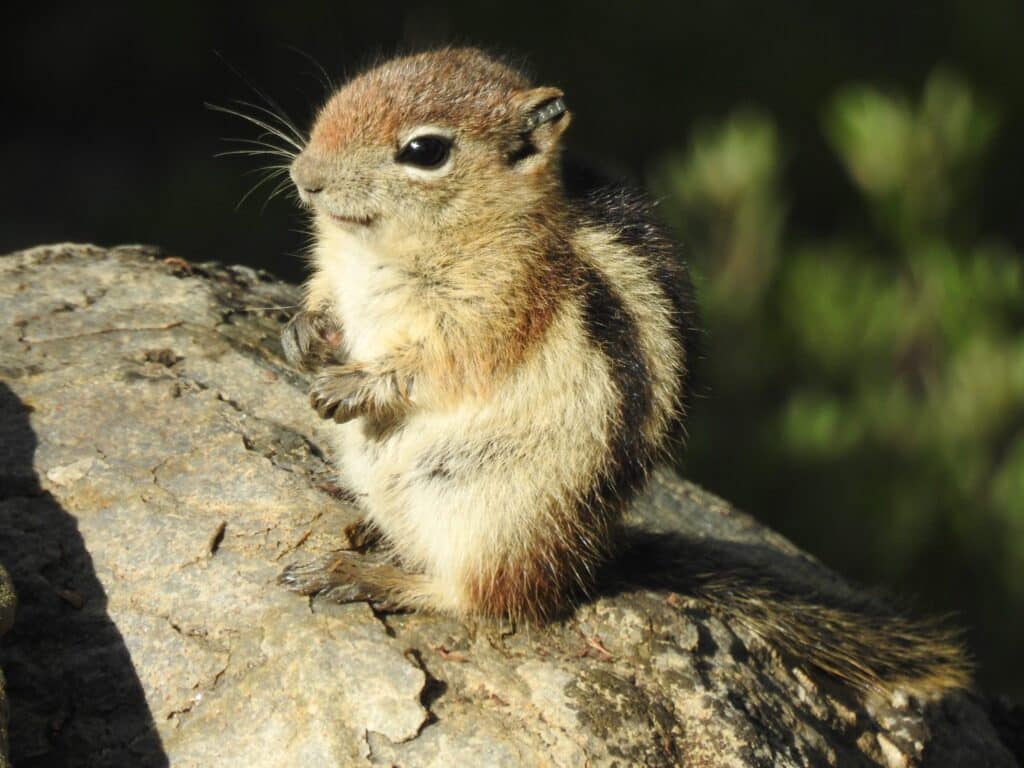
The yellow ground squirrel is a large rodent native to Central Asia, particularly Russia and Kazakhstan.
It has a strong body covered in yellowish-brown fur, can grow up to 12 inches long, and weighs around 1 pound.
These squirrels are burrowers, creating complex underground networks where they live in colonies.
- Region of Habitat: Central Asia, including Russia and Kazakhstan
- Scientific Name: Spermophilus fulvus
- Place of Origin: Central Asian steppes and deserts
- Feeding Habits: Herbivorous, feeding on seeds, grasses, and roots
- What Sound They Make: Whistles and chirps to communicate with other squirrels
Fun Facts: Yellow ground squirrels are highly social animals. They live in large colonies, working together to maintain their burrows and watching for predators.
They hibernate during winter, storing fat reserves to survive the cold. These squirrels play an important role in their ecosystem by aerating the soil and providing food for predators.
14. Yellowjacket

The yellowjacket is a type of wasp known for its aggressive behavior and vivid black and yellow stripes.
These wasps measure about 0.5 to 0.75 inches in length and are often mistaken for bees due to their similar coloring.
Yellowjackets are social insects living in large colonies containing thousands of individuals.
- Region of Habitat: North America, Europe, and temperate regions worldwide
- Scientific Name: Vespula or Dolichovespula (depending on the species)
- Place of Origin: Various, depending on the species, commonly found in woodlands and urban areas
- Feeding Habits: Carnivorous, feeding on insects, fruits, and nectar
- What Sound They Make: Buzzing and aggressive buzzing when threatened
Fun Facts: Yellowjackets are known for their painful sting, which they can deliver multiple times without dying, unlike bees.
They are particularly aggressive in the late summer and fall when food becomes scarce. Despite their fearsome reputation, yellow jackets are crucial in controlling pest insect populations, making them important in their ecosystems.
15. Yellow Mongoose
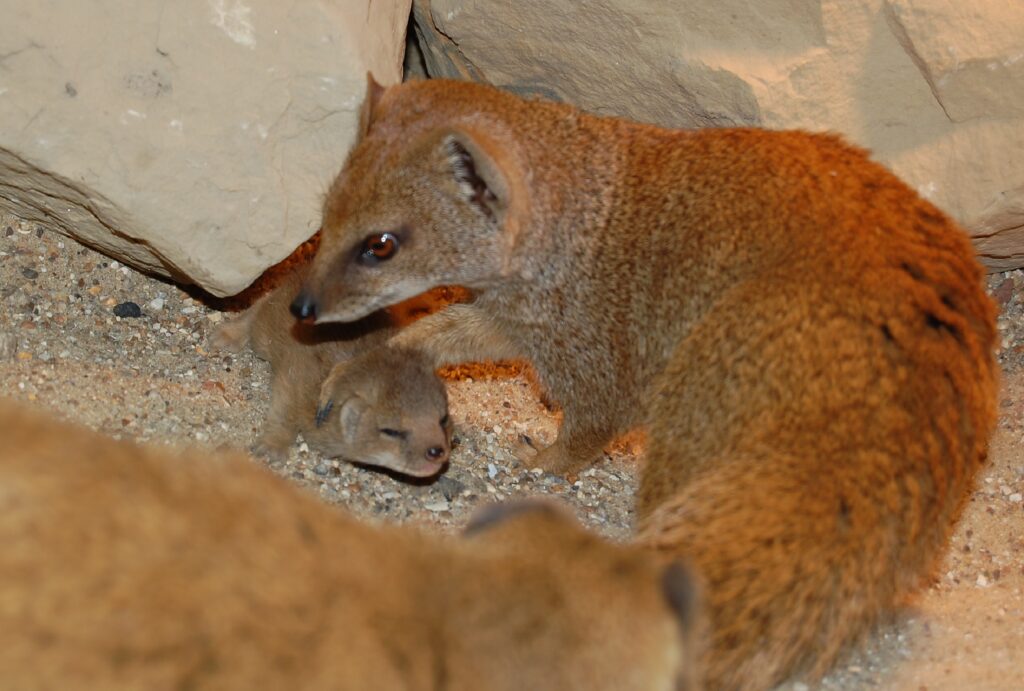
The yellow mongoose is a small carnivorous mammal native to Southern Africa. It has a slender body covered in yellow to reddish fur, with a bushy tail that is lighter on the underside.
These animals typically measure about 20 inches in length, including the tail, and weigh around 1 to 2 pounds.
Yellow mongooses are known for their agility and ability to take down prey larger than themselves.
- Region of Habitat: Southern Africa, particularly in Namibia, Botswana, and South Africa
- Scientific Name: Cynictis penicillata
- Place of Origin: Southern African savannas and grasslands
- Feeding Habits: Carnivorous, feeding on insects, small mammals, and reptiles
- What Sound They Make: Chattering and high-pitched squeals
Fun Facts: Yellow mongooses are highly social animals, often living in colonies with multiple families.
They are known to form symbiotic relationships with other species, such as ground squirrels and meerkats, sharing burrows and providing mutual protection from predators.
These mongooses are also known for their playful behavior, often seen chasing each other and wrestling.
16. Yellow-Throated Marten

The yellow-throated marten is a large, colorful member of the weasel family found in Asia. Its vibrant yellow throat and chest are easily recognizable, contrasting with its dark brown back and limbs.
These martens can grow up to 28 inches long, with a tail of similar size, and weigh between 4 and 9 pounds.
They are swift hunters known for climbing trees and chasing down prey.
- Region of Habitat: South and Southeast Asia, including the Himalayas, China, and Thailand
- Scientific Name: Martes flavigula
- Place of Origin: Asian forests and mountainous regions
- Feeding Habits: Omnivorous, feeding on small mammals, birds, fruits, and honey
- What Sound They Make: Screeches and growls, particularly when threatened
Fun Facts: Yellow-throated martens are known for their bold and curious nature, often approaching humans or exploring new environments without fear.
They are highly territorial and can be quite vocal when defending their territory. These martens have a varied diet and are known to raid beehives for honey, making them unpopular with beekeepers.
17. Yellow Sac Spider

The yellow sac spider is a small, nocturnal spider found in the United States and other parts of the world.
It is typically pale yellow or light green and has a body length of about 0.25 to 0.5 inches.
Yellow sac spiders are active hunters, known for their quick movements and ability to capture prey without using a web.
- Region of Habitat: United States, Europe, Africa, and parts of Asia
- Scientific Name: Cheiracanthium inclusum or Cheiracanthium miles (depending on the region)
- Place of Origin: Various, commonly found in gardens, homes, and other sheltered areas
- Feeding Habits: Carnivorous, feeding on insects and other small arthropods
- What Sound They Make: No audible sound; they are silent creatures
Fun Facts: Yellow sac spiders are known for their potentially painful bite, which can cause mild necrosis in some cases.
Despite their small size, they are aggressive hunters and will actively seek out prey rather than waiting in a web.
These spiders also build small silk sacs, resting during the day and protecting their eggs.
18. Yellow-Bellied Sea Snake

The yellow-bellied sea snake is a highly venomous snake found in warm ocean waters worldwide.
It has a distinctive yellow belly and a dark brown to black back. These snakes can grow up to 3.3 feet in length and are known for their unique adaptations to marine life, including the ability to live at sea.
- Region of Habitat: Tropical and subtropical oceans worldwide
- Scientific Name: Hydrophis platurus
- Place of Origin: Tropical oceans, particularly in the Indo-Pacific region
- Feeding Habits: Carnivorous, feeding on fish and eels
- What Sound They Make: Hissing
Fun Facts: The yellow-bellied sea snake is one of the most widely distributed snake species in the world, found in oceans from the Indian Ocean to the Pacific Ocean and even as far as the coasts of Central America.
These snakes are fully adapted to life at sea. They can breathe through their skin, allowing them to stay submerged for extended periods.
19. Yellow Longnose Butterflyfish

The yellow longnose butterflyfish is a brightly colored marine fish known for its distinctive long snout and vibrant yellow body.
It typically measures about 8 inches in length and is often found in coral reefs, where it uses its elongated snout to feed on small invertebrates hidden in crevices.
- Region of Habitat: Indo-Pacific region, particularly in coral reefs
- Scientific Name: Forcipiger flavissimus
- Place of Origin: Coral reefs in the Indo-Pacific region
- Feeding Habits: Omnivorous, feeding on small invertebrates, algae, and coral polyps
- What Sound They Make: No audible sound; they are silent creatures
Fun Facts: The yellow longnose butterflyfish is known for its striking appearance and graceful swimming style, making it a popular choice for home aquariums.
Its long snout is perfectly adapted for reaching into narrow crevices in coral reefs to extract prey. These fish are also known to form monogamous pairs, often seen swimming together in the wild.
20. Yellow-Bellied Marmot

The yellow-bellied marmot is a large ground squirrel found in the mountainous regions of North America.
It has a stocky build, a body length of up to 24 inches, and a weight of 5 to 11 pounds.
The marmot’s fur is typically brown with a yellowish belly. It is known for its hibernation habits, spending up to eight months of the year in a state of dormancy.
- Region of Habitat: Western North America, particularly in the Rocky Mountains and Sierra Nevada
- Scientific Name: Marmota flaviventris
- Place of Origin: North American mountainous regions
- Feeding Habits: Herbivorous, feeding on grasses, flowers, and fruits
- What Sound They Make: Whistles and chirps, often used to alert others of danger
Fun Facts: Yellow-bellied marmots are also known as “whistle pigs” due to their loud whistling sound to warn their colony of approaching predators.
These marmots are social animals, often living in colonies and sharing burrows. They are among the few mammals that enter true hibernation, surviving the winter months by living off their fat reserves.
21. Yellow-Winged Bat

The yellow-winged bat is a species native to Africa, known for its distinctive yellow wings and ears.
Its body length is about 3 to 4 inches, and its wingspan is around 12 inches. These bats are insectivorous, feeding primarily on small insects, which they catch in flight using their echolocation abilities.
- Region of Habitat: Sub-Saharan Africa, particularly in savannas and woodlands
- Scientific Name: Lavia frons
- Place of Origin: African savannas and woodlands
- Feeding Habits: Insectivorous, feeding on moths, beetles, and other flying insects
- What Sound They Make: High-pitched echolocation clicks and squeaks
Fun Facts: The yellow-winged bat is one of the few species of bats with brightly colored wings, which are thought to play a role in communication and mating displays.
These bats are solitary and typically roost in dense foliage during the day, emerging at dusk to hunt.
Their echolocation calls are among the highest-frequency sounds produced by any bat species.
22. Yacare Caiman

The yacare caiman is a crocodilian species found in South America, particularly in the wetlands and rivers of Brazil, Argentina, and Paraguay. It can grow up to 10 feet long and weigh over 200 pounds.
The yacare caiman is known for its rough, bumpy skin and powerful bite, which it uses to capture prey such as fish and small mammals.
- Region of Habitat: South America, particularly in Brazil, Argentina, and Paraguay
- Scientific Name: Caiman yacare
- Place of Origin: South American wetlands and rivers
- Feeding Habits: Carnivorous, feeding on fish, birds, and small mammals
- What Sound They Make: Grunts, bellows, and hissing
Fun Facts: Yacare caimans were heavily hunted for their skin during the 20th century, leading to a significant decline in their population.
However, thanks to conservation efforts and protections, their numbers have rebounded in recent decades.
These caimans are often seen basking on riverbanks during the day and are known for controlling fish populations to maintain the balance of aquatic ecosystems.
23. Yapok

The yapok, also known as the water opossum, is a small marsupial found in Central and South America.
It is the only aquatic marsupial species with webbed hind feet, which it uses to swim in rivers and streams.
Yapoks typically measure about 16 inches in length, have a tail of similar size, and weigh around 1 to 2 pounds.
- Region of Habitat: Central and South America, particularly in riverine environments
- Scientific Name: Chironectes minimus
- Place of Origin: Central and South American rivers and streams
- Feeding Habits: Carnivorous, feeding on fish, crustaceans, and aquatic insects
- What Sound They Make: Squeaks and hisses
Fun Facts: Yapoks are unique among marsupials for their fully webbed hind feet, which make them excellent swimmers.
Both male and female yapoks have pouches, with the female’s pouch being watertight to protect her young while swimming.
These nocturnal creatures are highly elusive and rarely seen by humans, making them one of the more mysterious animals of the Americas.
24. Yoranian

The yoranian, also known as a Yorkie Pom, is a small hybrid dog breed created by crossing a Yorkshire Terrier with a Pomeranian.
These dogs are tiny, typically weighing between 3 to 7 pounds and standing about 6 to 10 inches tall.
Yoranians are known for their playful and affectionate nature, making them popular companion animals.
- Region of Habitat: Domestic, found in homes worldwide
- Scientific Name: Canis lupus familiaris
- Place of Origin: United States, from crossbreeding of Yorkshire Terriers and Pomeranians
- Feeding Habits: Omnivorous, fed on commercial dog food and table scraps
- What Sound They Make: Barking and yipping
Fun Facts: Despite their small size, Yoranians are known for their bold personalities and can be quite protective of their owners.
They are highly intelligent and can be easily trained, although they may have a stubborn streak.
These dogs are also known for their long, fluffy coats, which require regular grooming to keep them looking their best.
25. Yokohama Chicken
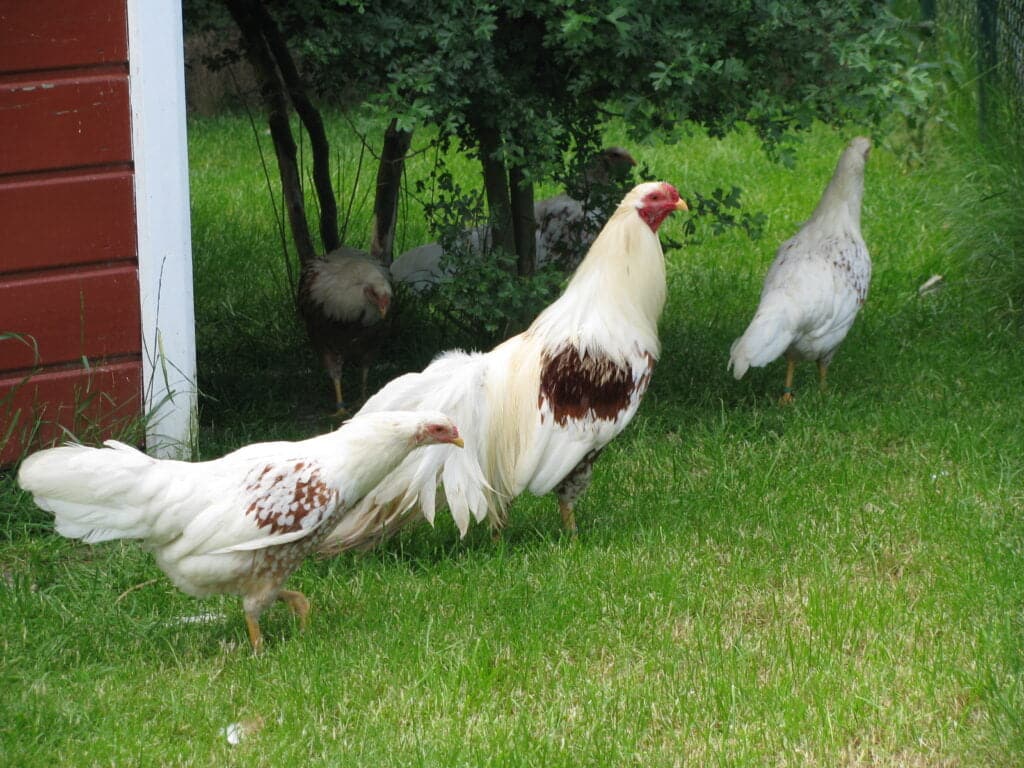
The Yokohama chicken is an ornamental breed known for its exceptionally long tail feathers, reaching up to 4 feet.
These chickens are small, with males weighing around 4 pounds and females slightly less.
They have sleek, grand, snow-white feathers, making them popular in poultry shows.
- Region of Habitat: Domestic, originally from Japan, now found worldwide
- Scientific Name: Gallus gallus domesticus
- Place of Origin: Japan, particularly from the Yokohama region
- Feeding Habits: Omnivorous, feeding on grains, seeds, and insects
- What Sound They Make: Crowing, clucking, and chirping
Fun Facts: The Yokohama chicken was originally bred in Japan from long-tailed fowl, and it was brought to Europe in the 19th century, where it became popular as an ornamental breed.
These chickens are not known for their egg-laying abilities, as they are primarily kept for their striking appearance.
Their long tails require special care, including plenty of space to prevent damage.
26. Yellow-Throated Warbler

The yellow-throated warbler is a small songbird found in North America, known for its bright yellow throat and black-and-white striped face.
These warblers typically measure about 5 inches in length and weigh around 0.3 ounces. They are often seen in pine forests and along the edges of swamps, where they forage for insects among the branches.
- Region of Habitat: Southeastern United States, particularly in pine forests and swamps
- Scientific Name: Setophaga dominica
- Place of Origin: Southeastern United States
- Feeding Habits: Insectivorous, feeding on caterpillars, beetles, and spiders
- What Sound They Make: High-pitched trills and whistles
Fun Facts: The yellow-throated warbler is a migratory bird, spending the breeding season in the southeastern United States and migrating to the Caribbean and Central America for the winter.
These singers are known for their acrobatic foraging behavior, often seen hanging upside down from branches as they search for food. Their song is a familiar sound in the pine forests where they reside.
27. Yellow Spotted Lizard

The yellow-spotted lizard is a nocturnal lizard native to Central America. It has a slender body covered in small yellow spots and can grow up to 12 inches in length.
These lizards are known for their secretive nature, often hiding under rocks or in crevices during the day and emerging at night to hunt for insects.
- Region of Habitat: Central America, particularly in tropical forests and rocky areas
- Scientific Name: Lepidophyma flavimaculatum
- Place of Origin: Central American tropical forests
- Feeding Habits: Insectivorous, feeding on beetles, ants, and other small insects
- What Sound They Make: No audible sound; they are silent creatures
Fun Facts: The yellow-spotted lizard has gained notoriety through popular culture, particularly in the book “Holes,” which depicts it as a highly dangerous creature.
These lizards are harmless to humans and play an important role in controlling insect populations in their native habitats.
They are also one of the few lizard species that give birth to live young rather than laying eggs.
28. Yellow-Bellied Weasel
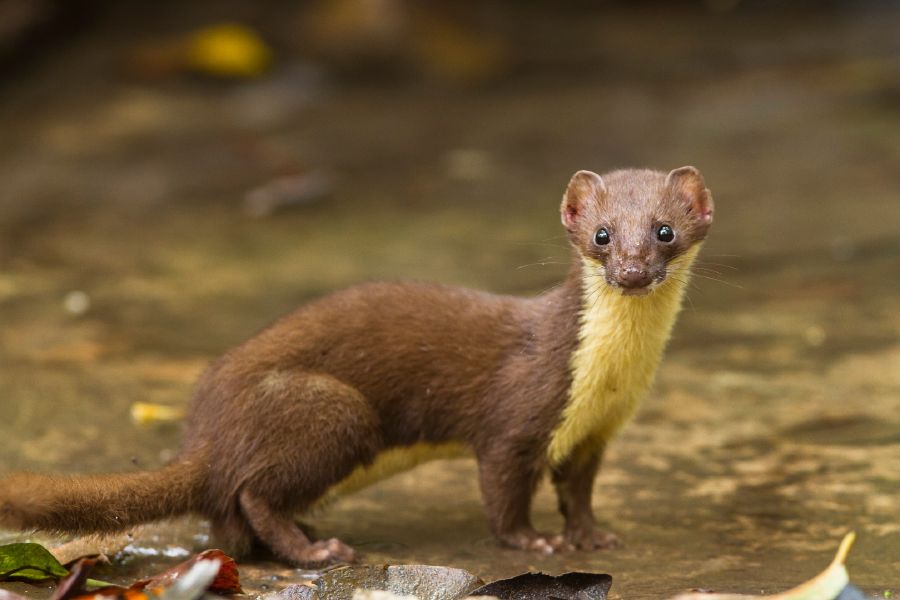
The yellow-bellied weasel is a small carnivorous mammal found in Asia. It has a slender body with a yellowish-brown back and a bright yellow belly.
These weasels typically measure about 12 inches long, with a tail of similar size, and weigh around 1 to 2 pounds.
They are quick-moving hunters known for their ability to catch prey much larger than themselves.
- Region of Habitat: South and Southeast Asia, including the Himalayas and China
- Scientific Name: Mustela kathiah
- Place of Origin: Asian mountainous regions and forests
- Feeding Habits: Carnivorous, feeding on rodents, birds, and insects
- What Sound They Make: High-pitched squeals and growls
Fun Facts: Yellow-bellied weasels are known for their fierce hunting abilities, often taking down prey much larger than themselves, such as rabbits and large birds.
They are highly territorial and can be quite aggressive when threatened. These weasels are also known for their ability to climb trees and swim, making them versatile hunters in their native habitats.
29. Yuma Myotis

The Yuma myotis is a small bat species in the southwestern United States. It has a wingspan of about 9 to 10 inches and weighs less than half an ounce.
These bats are insectivorous, feeding on various flying insects, including mosquitoes, which they catch in flight using their echolocation abilities.
- Region of Habitat: Southwestern United States, particularly in desert and riparian areas
- Scientific Name: Myotis yumanensis
- Place of Origin: Southwestern United States
- Feeding Habits: Insectivorous, feeding on mosquitoes, moths, and beetles
- What Sound They Make: High-frequency echolocation clicks and squeaks
Fun Facts: The Yuma myotis is often found near water sources, where it hunts for insects attracted to the water.
These bats are highly social, often roosting in large colonies in caves, buildings, or under bridges.
They are also known for their incredible agility in flight, ability to make sharp turns, and sudden dives to catch prey.
30. Yidiyidi
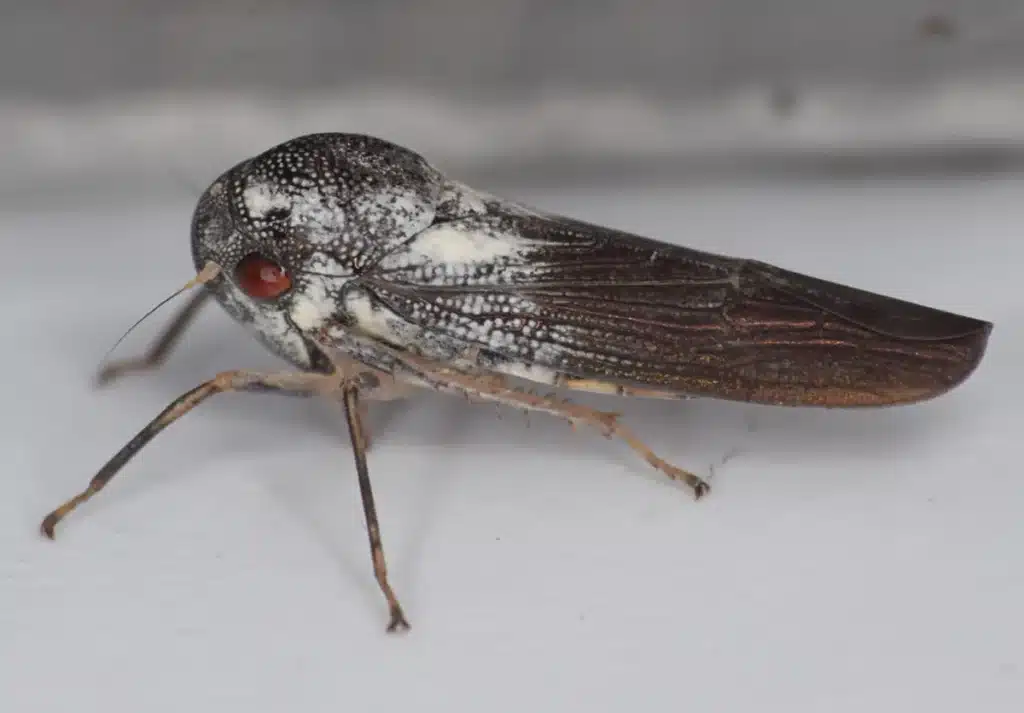
The Yidiyidi is a recently described species of cicada native to Western Australia. It is a small, green insect that appears after the rainy season in December.
Yidiyidi cicadas are known for their loud, high-pitched calls, which they use to attract mates. They typically measure about 1 to 1.5 inches in length.
- Region of Habitat: Western Australia, particularly in tropical and subtropical regions
- Scientific Name: Cicadidae (specific species yet to be formally classified)
- Place of Origin: Western Australia
- Feeding Habits: Herbivorous, feeding on plant sap
- What Sound They Make: Loud, high-pitched buzzing and clicking
Fun Facts: The Yidiyidi cicada was only recently described by scientists in 2022, although it has been known to the local Aboriginal communities for much longer.
These cicadas are an important part of the local ecosystem, serving as a food source for birds and other predators.
Their emergence after the rains is a key event in the life cycle of many species in the region.
31. Yellow-Bellied Glider
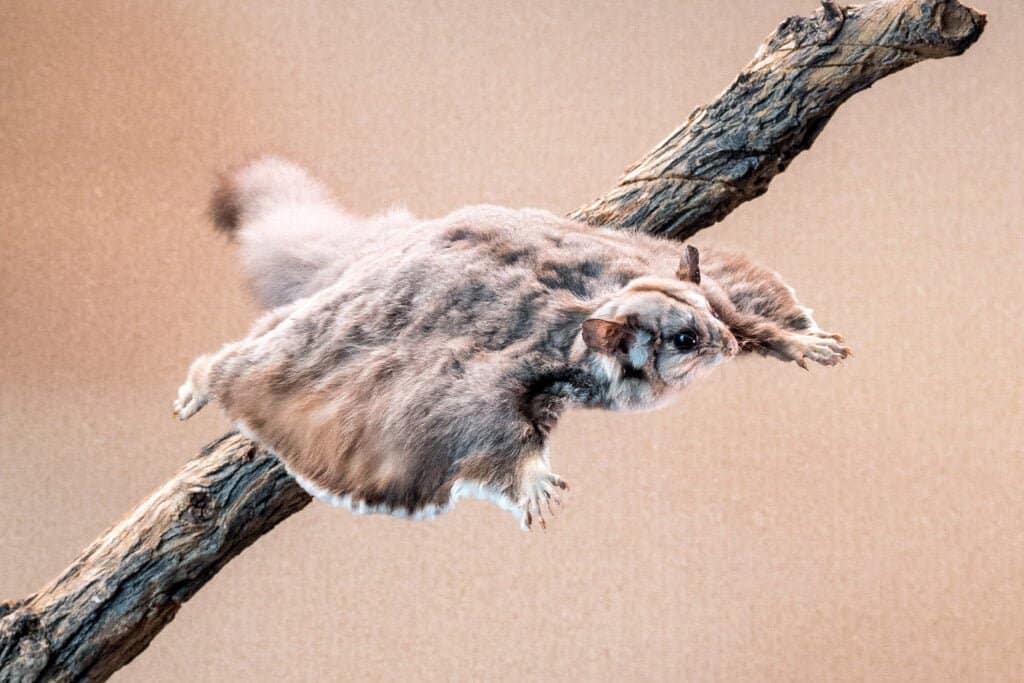
The yellow-bellied glider is a nocturnal marsupial native to Australia. It is known for gliding between trees using a skin membrane that extends from its forelimbs to its hindlimbs.
These gliders are about 12 inches long, have an even longer tail, and weigh 1 to 2 pounds. Their fur is gray with a distinctive yellow belly.
- Region of Habitat: Eastern Australia, particularly in eucalypt forests
- Scientific Name: Petaurus australis
- Place of Origin: Australian eucalypt forests
- Feeding Habits: Omnivorous, feeding on tree sap, nectar, insects, and small vertebrates
- What Sound They Make: Loud, gurgling calls at night
Fun Facts: Yellow-bellied gliders are highly social animals, often living in family groups and communicating through various vocalizations.
They can glide up to 100 meters (about 330 feet) between trees, which helps them avoid ground predators.
These gliders are also known for their complex social structures and cooperative behaviors, such as sharing food and grooming each other.
32. Yellow-Backed Lorikeet

The yellow-backed lorikeet is a small, colorful parrot native to New Guinea and nearby islands.
Its bright yellow back, green wings, and red chest make it one of the most vividly colored birds in its habitat.
These lorikeets are about 6 to 7 inches long and weigh around 2 ounces. They are known for their playful behavior and acrobatic flight.
- Region of Habitat: New Guinea and nearby islands
- Scientific Name: Trichoglossus flavoviridis
- Place of Origin: Tropical rainforests of New Guinea
- Feeding Habits: Nectarivorous, feeding on nectar, pollen, and fruit
- What Sound They Make: High-pitched chattering and screeching
Fun Facts: Yellow-backed lorikeets are highly social birds, often found in flocks of up to 20 individuals.
They are known for their acrobatic flight, often seen hanging upside down from branches while feeding.
These lorikeets play a crucial role in pollinating the flowers of the trees they feed on, making them important to the health of their ecosystems.
33. Yellow-Bellied Toad

The yellow-bellied toad is a small amphibian found in Central and Eastern Europe. Its body is flat and grayish-brown, and its bright yellow belly warns potential predators of its toxicity.
These toads are about 1.5 to 2 inches long and are known for their distinctive “unkenreflex” defensive posture. They arch their backs to display their yellow belly.
- Region of Habitat: Central and Eastern Europe, particularly in wetlands and ponds
- Scientific Name: Bombina variegata
- Place of Origin: European wetlands and ponds
- Feeding Habits: Carnivorous, feeding on insects, worms, and small invertebrates
- What Sound They Make: Melodic, repetitive calls, often heard during the breeding season.
Fun Facts: The yellow-bellied toad is one of the few amphibians that can tolerate polluted or brackish water, making it well-suited to survive in human-altered landscapes.
Its bright yellow belly is a form of aposematic coloration, warning predators that it is toxic and should not be eaten.
These toads are also known for their “unkenreflex” defensive behavior, where they expose their belly to deter predators.
Conclusion
As we wrap up our expedition through the world of animals that start with Y, it’s clear how mixed and remarkable these creatures are.
Each animal plays a unique role in its ecosystem, from the hardy yak of the Himalayas to the mysterious yellow-eyed penguin of New Zealand.
Our exploration has shown that Y-named animals can be found in diverse habitats across the globe.
Some, like the yellowhammer, face challenges due to changing environments, while others, like the yeti crab, continue to surprise scientists with their adaptations.
By learning about these animals, we gain a deeper appreciation for the natural world’s complexity.
Whether you’re a wildlife enthusiast or simply curious, we hope this guide has sparked your interest in these mesmerizing creatures.
Next time you encounter an animal that starts with Y, you’ll have a new viewpoint on its place in nature.




